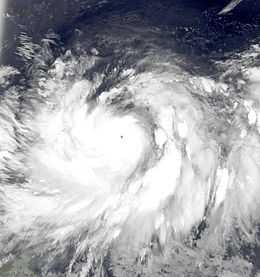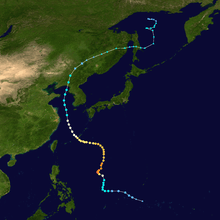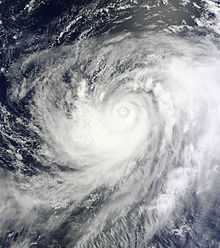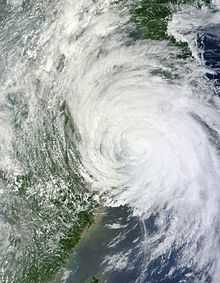Typhoon Muifa (2011)
| Typhoon (JMA scale) | |
|---|---|
| Category 5 (Saffir–Simpson scale) | |
 Typhoon Muifa at peak strength | |
| Formed | 27 July 2011 |
| Dissipated | 15 August 2011 |
| (Extratropical after 9 August) | |
| Highest winds |
10-minute sustained: 175 km/h (110 mph) 1-minute sustained: 260 km/h (160 mph) |
| Lowest pressure | 930 mbar (hPa); 27.46 inHg |
| Fatalities | 22 dead; 42 injured; 6 missing |
| Damage | $480 million (2011 USD) |
| Areas affected | Micronesia, Philippines, Japan, China, South Korea, North Korea |
| Part of the 2011 Pacific typhoon season | |
Typhoon Muifa, known in the Philippines as Typhoon Kabayan, was a large, strong and persistent typhoon which affected a number of countries in the Pacific, killing 22 and causing widespread damage worth US$480 million. It was the ninth named storm, third typhoon and the second super-typhoon of the 2011 Pacific typhoon season.
The low-pressure area which became the typhoon originally formed on 23 July. It gradually drifted to the west, becoming a tropical depression. As it turned north and neared the Philippines it rapidly strengthened, becoming a Category 5 typhoon on the Saffir-Simpson Hurricane Scale (SSHS). In the Philippines, the storm claimed eight lives and caused much damage. The system brought down trees; the northeast Philippines experienced strong winds and heavy rains, leaving motorists stranded on several roads and expressways. Muifa also sank a Malay ship with 178 passengers. The system then drifted north, weakening steadily until it curved to the west and threatened Micronesia. The typhoon hit Okinawa, Japan with 41 inches of rain, flooding the small island and injuring 37 people in a 30-hour period. The storm disrupted air travel, leaving 13,630 people stranded on the island. The system then steadily drifted west, nearing Taiwan and prompting emergency warnings and high alerts; however, the storm missed the island. The typhoon moved further west towards mainland China, causing thousands to flee from their homes. A level-4 high-wave warning was issued, and some 11,000 rescue workers mobilized in 120 teams.
Meteorological history

A parade of low-pressure areas and tropical disturbances formed from the Intertropical Convergence Zone late on 15 July. Late on 23 July, one of the last low-pressure systems developed further to a weak tropical disturbance, which formed southeast of Chuuk in Micronesia.[1] The system drifted to the west, and on July 25the Joint Typhoon Warning Center (JTWC) upgraded the low-pressure area to a tropical depression. At that time, it was located approximately 505 nautical miles (935 km; 581 mi) west of Guam.[2] At midnight that day, the JMA began monitoring the system as a tropical depression.[3] Early on 28 July, the JTWC upgraded the system to a tropical storm.[4] A few hours later the JMA also upgraded the system to a tropical storm, naming it Muifa.[5] Also on 28 July, the storm entered the Philippine Area of Responsibility (PAR); the Philippine Atmospheric, Geophysical and Astronomical Services Administration (PAGASA) named it Kabayan.[6] The storm drifted north over the next day, while maintaining tropical-storm strength. On the night of 29 July, Muifa was upgraded to a severe tropical storm.[7] Overnight, the storm strengthened rapidly and was upgraded to a typhoon the next morning.[8] According to the JTWC, Muifa had strengthened from a tropical storm to a super typhoon in less than 24 hours; it reported that the storm was reaching one-minute sustained wind speed of 140 knots (260 km/h; 160 mph). However, the typhoon weakened later in the day. According to the JTWC, on 31 July the typhoon encountered an upper-level trough and weakened to a category-4 typhoon on the SSHS.[9] The system gradually moved north, then turned west and drifted towards Okinawa before turning northwest again (when it was finally downgraded to a tropical storm by the JTWC).[10] Soon afterwards, the JMA downgraded Muifa to a severe tropical storm.[11] After weakening to a tropical storm, Muifa made landfall at the estuary of the Yalu River on 8 August and the JTWC issued its final warning. Early on 9 August, Muifa weakened to a tropical depression in northeast China and later became a low-pressure area.

Preparations
Okinawa
Japanese officials canceled several flights to Okinawa, leaving hundreds of passengers stranded.[12] On 5 August, China Airlines cancelled several flights to Okinawa; at that time, the eye of the storm was over Okinawa.[13]
Taiwan
Light rain with moderate winds were reported throughout Taiwan, as the outer rain bands of the system brushed the island nation.[14] The Central Weather Bureau (CWB) announced that heavy rains and strong winds would impact the Republic of China.[15] On 6 August the CWB lifted the sea warning for Taiwan, since the system had turned northwest and was no longer expected to cause any damage to the island.[16]
Mainland China
As the system approached mainland China, PRC authorities began ordering fishing boats back to shore. Residents of Shanghai were also warned, since the storm was expected to be as strong as Typhoon Matsa in 2005.[12] To prevent railway accidents during the storm, Shanghai railway authorities set up a team to inspect high-speed railway facilities.[17] The Ministry of Civil Affairs (MCA) issued a decree on 4 August ordering civil agencies in Shanghai and the provinces of Zhejiang, Jiangsu, Anhui, Fujian, Jiangxi and Shandong to carry out disaster-relief operations, preventing as many casualties as possible.[18] An orange alert, the second highest in the four-level sea-wave alert system, was issued on the East China Sea as the system neared land.[19] On 5 August the port of Ningbo, one of China's busiest ports, was partially shut down due to the typhoon.[20] PRC officials declared that the system was the strongest that year to date to impact the nation, as it passed Taiwan maintaining typhoon strength.[21] As a result, PRC officials temporarily closed several oil, dry-bulk and container ports.[22] Millions of people living along the coast were ordered to stay indoors, and several hundred flights were cancelled as the typhoon was expected to be the worst to affect China's commercial centre since 2005.[23] Landfall was initially expected over Zhejiang Province on Saturday, 6 August. The storm was expected to bring rainfall to more than ten provinces, over an area of one million square kilometers.[24]

On 6 August, as the typhoon approached, over 200,000 people were evacuated from low-lying areas; however, although 140 more flights were cancelled the typhoon was no longer expected to directly impact the nation.[25] The meteorological agency announced that heavy rain and strong winds would affect the nation for three days, beginning on 7 August.[26] Some 11,000 rescue workers in 120 teams were mobilized to respond to the storm and protect as many people as possible.[27] The National Marine Environmental Forecasting Center issued a red alert (the highest alert in the four-level high-wave warning system) as the system swept across the East China Sea at typhoon strength. Waves as high as 9–11 meters were expected throughout the East China Sea.[28] Shanghai railway authorities established an emergency response plan: if Muifa's winds were less than 62 km/h in Shanghai, the subway would be manually operated at low speed. If winds were greater than 89 km/h, the trains would be cancelled.[29] Both airports in Shanghai were closed, and all outdoor events were also cancelled or postponed.[30] As the system neared land, the Shanghai government urged residents to stay indoors with first-aid kits and emergency supplies.[31] A message from the federal government of the United States to Americans living in China advised them to "stock up on emergency supplies of food, water, and cash in case of storm-related power outages".[32]
As the system brushed Shanghai, residents of Qingdao began their preparations for the storm. Although weaker, the system's heavy surf battered Qingdao's waterfront and the beaches were closed.[33] As reported on 9 August, some 1.35 million people were evacuated as the system approached its final landfall in northern China.[34]
Impact
| Country | Casualties | Damage (USD) | ||
| Deaths | Injuries | Missing | ||
| Mainland China | 0 | 0 | 1 | ~$480 million |
| Japan | 0 | 37 | 0 | N/A |
| Philippines | 8 | 5 | 3 | $59,428 |
| South Korea | 4 | 0 | 2 | N/A |
| North Korea | 10 | 0 | 0 | N/A |
| Taiwan | 0 | 0 | 0 | N/A |
| Total | 22 | 42 | 6 | ~$480 million |
Philippines
Although the storm did not directly impact to the Philippines, its rain bands caused considerable damage to the nation. According to a situation report by the National Disaster Risk Reduction and Management Council(NDCC), the typhoon killed four people and caused damage worth USD$59,203.[35] On 2 August thousands of people living near the Marikina River in Metro Manila fled as alert level 2 was issued, after water rose to dangerously-high levels.[36] Minutes before the announcement was made, the Malacañan Palace released an order closing schools, colleges and offices.[37] Authorities mobilized emergency personnel to ready evacuations from areas near the capital region's rivers and canals, where flood waters were rising.[38] On 4 August, the NDRRMC raised the death toll to eight and total damage to agriculture and infrastructure to USD$59,428. It was reported that CGAC in Iloilo coordinated commercial vessels rescuing 178 passengers after its ship, MV Malaysia Asia, sank near Calabazas Island, Ajuy, Iloilo.[39]
Okinawa
Okinawa suffered minor damage, with no fatalities. Overall, 41 inches of rain fell over the island and major roads were closed for days. Thirty-seven people were injured, six critically. Nearly 300 flights were cancelled, leaving 13,630 stranded.[40]
China
Offshore, ten fishing vessels (with about 200 people aboard) were reported missing; however, there was uncertainty about whether Muifa was the cause.[41] On 7 August, as the typhoon brushed the coast of Shanghai, a major sea bridge linking the urban area to an outlying island was closed.[42] Heavy rains and strong winds battered the city, and some 400,000 people were moved to evacuation centers. Tens of thousands of fishing boats remained in port.[43] Hundreds of flights were cancelled, leaving thousands of passengers stranded. One person was reported missing as a boat sank off Zhejiang in storm surge associated with Muifa.[44] Strong winds knocked down billboards and cut power in two residential areas of Shanghai. However, the typhoon weakened before it reached the city and many stores remained open.[45]
Although weakened, the storm wreaked havoc in Zhejiang province; 169 houses, 3,500 tonnes of crops and 121,300 tonnes of aquatic products were destroyed. Economic losses were estimated at US$289.9 million.[46] The system threatened the chemical plant in Dalian; authorities reported that loads of rocks were dumped along the coastline to prevent damage to the plant from the 25-metre (82 ft)-high waves spawned by the storm.[47]
On 9 August, as the system approached its final landfall, a total of 183 counties in China's coastal provinces were reported to be battered by the system and estimates of economic loss were raised to US$480 million.[48] The system battered the provinces of Liaoning, Zhejiang and Jiangsu, affecting 1.74 million residents and damaging 101,000 hectares of farmland.[49]
Korean Peninsula
In South Korea the system felled trees, outed power and caused the cancellation of many Seoul-bound flights.[50] Heavy rain and strong winds were experienced on the west Korean coast.[51] Four people were killed and two others were missing in South Korea due to the storm.[52] In North Korea the storm destroyed 2,400 acres of cropland, 100 houses and 10 public buildings, leaving 10 people dead.[53]
Aftermath
A chemical spill was feared after the typhoon made landfall near Liaoning Province's Fujia Dahua petrochemical plant. The plant produces paraxylene (PX), a deadly, flammable and carcinogenic liquid chemical.[54] Although a spill did not occur, the breaching of dikes around the city of Dalian highlighted the risk of such a spill and triggered the Dalian PX protest on 14 August.
See also
References
- ↑ "NWS Guam — Tropical Cyclone Advisory 231930 for pre-tropical storm Muifa". NOAA. Retrieved 28 July 2011.
- ↑ "JTWC — Tropical Cyclone Advisory 001 – Pre-tropical storm Muifa". Joint Typhoon Warning Center. Retrieved 28 July 2011.
- ↑ "JMA — Tropical Cyclone Advisory 260000 – Pre-tropical storm Muifa". Japan Meteorological Agency. Retrieved 28 July 2011.
- ↑ "JTWC — Tropical Storm 11W — Warning 011". Joint Typhoon Warning Center. Retrieved 28 July 2011.
- ↑ "JMA — Tropical Cyclone Advisory 280600 – Tropical Storm Muifa". Japan Meteorological Agency. Retrieved 28 July 2011.
- ↑ "PAGASA — Severe Weather Bulletin Number ONE — Tropical Storm Kabayan". PAGASA. Retrieved 28 July 2011.
- ↑ "JMA Tropical Cyclone Advisory 300000 for Severe Tropical Storm Muifa". Japan Meteorological Agency. Retrieved 30 July 2011.
- ↑ "JMA – Tropical Cyclone Advisory 300600 – Typhoon Muifa". Japan Meteorological Agency. Retrieved 30 July 2011.
- ↑ "JTWC – Super Typhoon Muifa – Warning 24". Joint Typhoon Warning Center. Retrieved 31 July 2011.
- ↑ "JTWC – Tropical Cyclone Warning 51 – Post-Super Typhoon Muifa". Joint Typhoon Warning Center. Retrieved 7 August 2011.
- ↑ "JMA – Tropical Cyclone Advisory 070600 – Severe Tropical Storm Muifa". Japan Meteorological Agency. Retrieved 7 August 2011.
- ↑ 12.0 12.1 "China, Japan Brace as Super Typhoon Muifa Approaches". Voice of America. Retrieved 4 August 2011.
- ↑ "China Airlines cancels Taipei-Okinawa flights due to typhoon". The Central News Agency. Retrieved 5 August 2011.
- ↑ "Powerful typhoon dusts Taiwan, heads for China". Newsday. Retrieved 5 August 2011.
- ↑ "Heavy rains expected around midnight: CWB". The Central News Agency. Retrieved 5 August 2011.
- ↑ "CWB lifts sea warning for Typhoon Muifa". The Central News Agency. Retrieved 6 August 2011.
- ↑ "UPDATE 1-Shanghai, nearby ports brace for powerful typhoon". Thomson Reuters. 4 August 2011. Retrieved 4 August 2011.
- ↑ "Eastern China on alert as typhoon Muifa approaches". Xinhua News Agency. Retrieved 4 August 2011.
- ↑ "China issues alert as Typhoon Muifa approaches". Xinhua News Agency. Retrieved 4 August 2011.
- ↑ Wong, Fayen (5 August 2011). "China's Ningbo port partially shut ahead of typhoon". Reuters. Retrieved 5 August 2011.
- ↑ "Typhoon Muifa approaches China, prompting high alert". London: Guardian News and Media. 5 August 2011. Retrieved 5 August 2011.
- ↑ "UPDATE 2-Japan, China shut ports in path of powerful typhoon". Thomson Reuters. 5 August 2011. Retrieved 5 August 2011.
- ↑ "China braces for worst typhoon in years". AFP (Google News). Retrieved 5 August 2011.
- ↑ "Typhoon Muifa likely to land in east China over weekend". Xinhua News Agency. Retrieved 5 August 2011.
- ↑ "China evacuates 200,000 ahead of typhoon". Herald and Weekly Times. Retrieved 6 August 2011.
- ↑ "Typhoon Muifa to bring gales, rain to China over next three days". Xinhua News Agency. Retrieved 6 August 2011.
- ↑ "Coast girds itself for Typhoon Muifa". China Daily. Retrieved 6 August 2011.
- ↑ "China issues highest alert as Typhoon Muifa sweeping East China Sea". Xinhua News Agency. Retrieved 6 August 2011.
- ↑ "East China braces for Typhoon Muifa". Xinhua News Agency. Retrieved 6 August 2011.
- ↑ "Powerful typhoon bears down on China's east coast". The Associated Press. Retrieved 6 August 2011.
- ↑ "Typhoon Muifa bears down towards China". AFP (Google News). Retrieved 6 August 2011.
- ↑ "Powerful typhoon bears down on China's east coast". Forbes. Retrieved 6 August 2011.
- ↑ "China's Qingdao braces for major typhoon's arrival". Fox News Network. 6 August 2011. Retrieved 7 August 2011.
- ↑ "1.35 mln evacuated as Muifa passes China". Xinhua News Agency. Retrieved 9 August 2011.
- ↑ "NDRRMC Update re SitRep No. 6 on Typhoon "KABAYAN" (MUIFA)". National Disaster Risk Reduction and Management Council. Retrieved 1 August 2011.
- ↑ "Marikina residents start to flee as Alert Level 2 sounded". GMA Network Inc. Retrieved 2 August 2011.
- ↑ "Palace suspends college classes, govt work in NCR". GMA Network Inc. Retrieved 2 August 2011.
- ↑ "Heavy flooding swamps Manila, gov't suspends work". San Jose Mercury News. Retrieved 2 August 2011.
- ↑ "NDRRMC Update re SitRep No. 12 on Typhoon "KABAYAN" (MUIFA)" (PDF). National Disaster Risk Reduction and Management Council. Retrieved 4 August 2011.
- ↑ "Typhoon 11 W (Muifa), # 30; UPDATED Storm Watch declared". Stars and Stripes. Retrieved 6 August 2011.
- ↑ Melanie Lee and Helen Ding (6 August 2011). "China braces for Typhoon Muifa, 200,000 evacuated". Reuters. Retrieved 6 August 2011.
- ↑ "Shanghai closes major bridges as Typhoon Muifa sweeps past". Xinhua News Agency. Retrieved 7 August 2011.
- ↑ "Shanghai soaked as typhoon heads along China coast". Newsday. Retrieved 7 August 2011.
- ↑ "Flights cancelled as typhoon nears Chinese coast". Google News (AFP). Retrieved 7 August 2011.
- ↑ "Typhoon Muifa misses Shanghai, veers toward Shandong". Thomson Reuters. 7 August 2011. Retrieved 7 August 2011.
- ↑ "Typhoon Muifa weakens as it moves along China's east coast". Xinhua News Agency. Retrieved 7 August 2011.
- ↑ "ke breach under control in NE China city". Xinhua News Agency. Retrieved 8 August 2011.
- ↑ "Muifa downgrades, rain continues in northeast China". Xinhua News Agency. Retrieved 9 August 2011.
- ↑ "Tropical storm Muifa causes economic losses of 3 bln yuan in China". Xinhua News Agency. Retrieved 9 August 2011.
- ↑ "Tropical storm Muifa nears Chinese mainland". BBC. 8 August 2011. Retrieved 8 August 2011.
- ↑ "Tropical storm brings rain, wind to China, NKorea". The Associated Press. Retrieved 8 August 2011.
- ↑ "(2nd LD) Typhoon Muifa passes S. Korea along west coast, killing 4". Yonhap News Agency. Retrieved 11 August 2011.
- ↑ "NKorea: Tropical storm causes casualties, damage". Taiwan News. Retrieved 9 August 2011.
- ↑ "Chemical Spill Scare After Tropical Storm Muifa Hits Chinese Coast". New Tang Dynasty Television. Retrieved 11 August 2011.
External links
| Wikimedia Commons has media related to Typhoon Muifa (2011). |
- JMA General Information of Typhoon Muifa (1109) from Digital Typhoon
- The JMA's Best Track Data on Typhoon Muifa (1109) (Japanese)
- The JMA's RSMC Best Track Data (Graphics) on Typhoon Muifa (1109)
- The JMA's RSMC Best Track Data (Text)
- The JTWC's Best Track Data on Super Typhoon 11W (Muifa)
- 11W.MUIFA from the U.S. Naval Research Laboratory
| ||||||||||